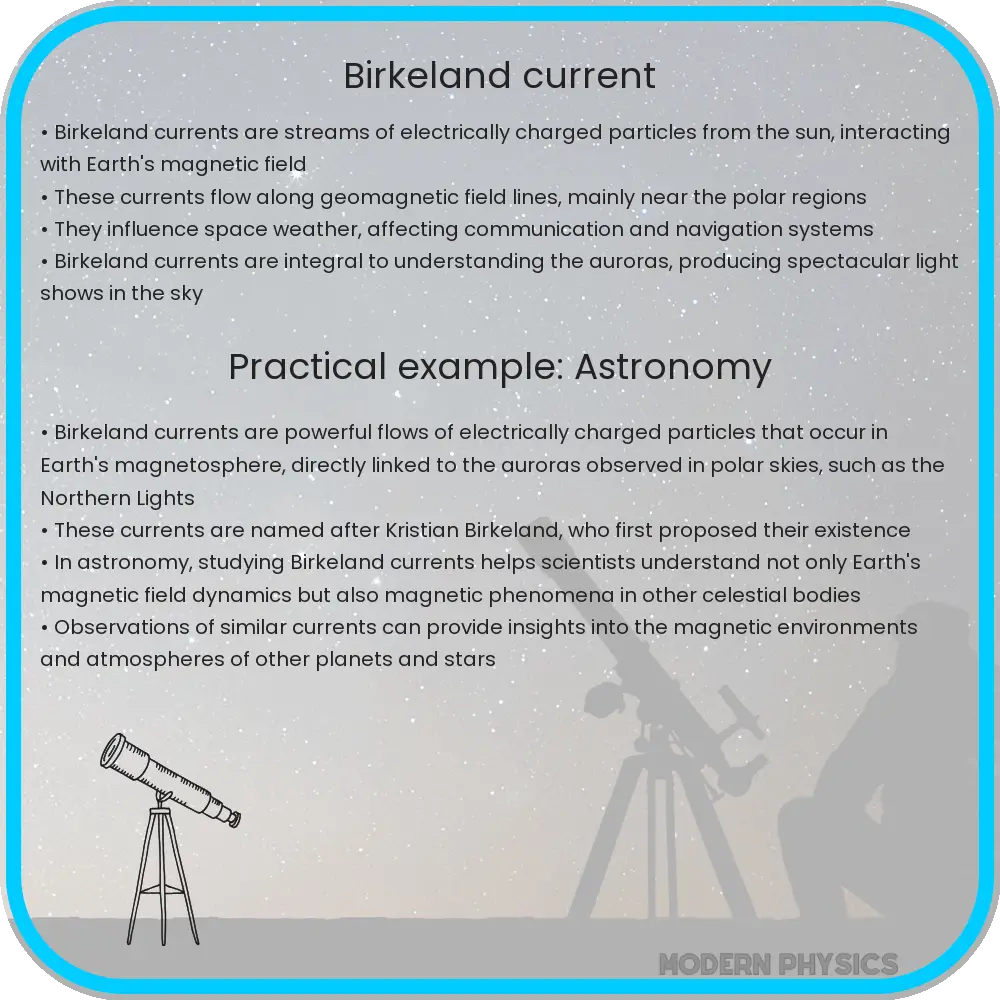Explore the mysteries of Birkeland currents, their impact on plasma physics, space weather, and technological systems, and the latest research shaping our understanding.

Unraveling the Mysteries of Birkeland Currents
Birkeland currents, named after the Norwegian scientist Kristian Birkeland who first proposed their existence in the early 20th century, are fascinating phenomena in the study of plasma physics and space weather. These currents are vast flows of electrically charged particles that travel along the Earth’s magnetic field lines, connecting the Earth’s magnetosphere to its ionosphere.
Research and Understanding
Initially, Birkeland’s theory was met with skepticism, but advancements in space exploration and technology have confirmed the existence of these currents. Today, research into Birkeland currents focuses on understanding their behavior, dynamics, and impact on both space weather and terrestrial phenomena. Instruments such as satellites and ground-based observatories have been pivotal in studying these currents, providing insights into their structure, strength, and variability.
Impact on Plasma Physics
In plasma physics, Birkeland currents serve as a real-world laboratory for studying fundamental processes such as magnetic reconnection, particle acceleration, and energy transfer in plasmas. These currents are not only limited to Earth; they have been observed in other planetary magnetospheres and are thought to play a significant role in shaping the space environment.
- Space Weather: Birkeland currents can influence space weather by affecting the Earth’s magnetosphere, leading to phenomena such as the aurora borealis and aurora australis. Their variability can also impact satellite operations, GPS systems, and power grids.
- Interplanetary Connections: The study of Birkeland currents extends beyond Earth, offering clues about the magnetic fields and atmospheres of other planets, as well as the Sun’s influence on the solar system.
- Technological Applications: Understanding Birkeland currents is crucial for developing technologies to mitigate their effects on human activities, such as improving the resilience of power systems and enhancing the reliability of communication and navigation systems.
The ongoing research and exploration of Birkeland currents underscore their importance in not only advancing our knowledge of space weather but also in addressing practical challenges faced by society due to our increasing reliance on technology. As we continue to unravel the mysteries of these electric currents, we pave the way for new discoveries and innovations in plasma physics and beyond.
Challenges and Future Directions
The study of Birkeland currents faces numerous challenges, primarily due to the vastness and complexity of the Earth’s magnetosphere. Precise measurements and modeling are required to fully understand these currents’ origins, structures, and effects. Future research efforts are directed towards integrating observations from multiple sources, including satellites and ground-based instruments, to develop more comprehensive models of Birkeland currents.
Another significant challenge lies in predicting the behavior of these currents. As our dependency on satellite technology grows, understanding the impact of space weather becomes increasingly crucial. Advanced forecasting models are being developed to predict the occurrence and impact of geomagnetic storms caused by fluctuations in Birkeland currents, aiming to safeguard technological infrastructure and communication networks.
Interdisciplinary Collaborations
The exploration of Birkeland currents is inherently interdisciplinary, merging plasma physics, space science, atmospheric science, and electrical engineering. Collaborations across these disciplines are vital for advancing our understanding and developing practical solutions to the challenges posed by these currents. For instance, the integration of atmospheric studies can provide insights into how Birkeland currents influence climate phenomena, while advancements in electrical engineering can lead to more resilient power and communication systems.
Conclusion
Birkeland currents represent one of the most intriguing and complex phenomena in plasma physics, offering a window into the dynamic processes that govern our space environment. Through decades of research, we have gained significant insights into these currents, yet many mysteries remain. The pursuit of understanding Birkeland currents not only satisfies our scientific curiosity but also addresses practical challenges, from improving space weather forecasting to enhancing the reliability and safety of our technological infrastructure. As we stand on the brink of new discoveries, the study of Birkeland currents promises to continue shaping our understanding of the universe and our place within it. The interdisciplinary nature of this research underscores the importance of collaboration and innovation in unraveling the mysteries of the cosmos and harnessing knowledge for the betterment of humanity.
